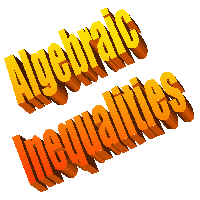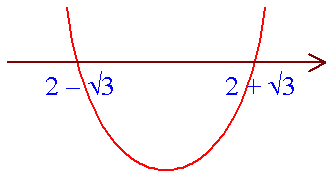 |
 |
 |
 |
 ome Important Properties
ome Important Properties
| na < nb, | a/n < b/n, | an < bn (if a, b > 0). |
| na > nb, | a/n > b/n, | an > bn (if a, b > 0). |
 olving An Inequalitiy
olving An InequalitiySolving an inequality in one real variable means to find (the set of) all real values which satisfy the given inequality.
Some points to take note when solving an inequality.
 nterval Notation & Set-builder Notation
nterval Notation & Set-builder Notation| Inequality | Interval Notation | Set-builder Notation |
| a < x < b | {x Î R : a < x < b} | |
| a < x £ b | {x Î R : a < x £ b} | |
| a £ x < b | {x Î R : a £ x < b} | |
| a £ x £ b | {x Î R : a £ x £ b} | |
| {x Î R : x > a} | ||
| {x Î R : x ³ a} | ||
| {x Î R : x < b} | ||
| {x Î R : x £ b} |
 uadratic Inequalities
uadratic InequalitiesExample 1: Find the solution set of x2 - 6x + 8 > 0.
Solution:
Graphically:
 |
\ x < 2 or x > 4.
The solution set is
|
Number line:
 |
\ x < 2 or x > 4.
The solution set is
|
Example 2: Find the solution set of (2x - 1)(x + 2) < x(4 + x).
Solution:
|
2x2 + 3x -
2
|
< | 4x + x2 |
|
x2 - x
- 2
|
< | 0 |
| (x + 1)(x - 2) | < | 0 |
 |
\ -1 <
x < 2.
The solution set is
|
Example 3: Solve x2 - 4x + 1 > 0.
Solution:
|
x2 - 4x
+ 1
|
|
x2 - 4x + 4 - 3 |
|
|
(x - 2)2 - 3 | |
|
(x - 2)2
- 3
|
|
0 |
|
(x - 2)2
|
|
3 |
|
|x - 2|
|
|
Ö3 |
|
x - 2 > Ö3
|
|
x - 2 < -Ö3 |
|
x > 2 + Ö3
|
|
x < 2 - Ö3 |
| x | = |
|
|||||||
| = | 2 ± Ö3 |
 |
\ for x2 - 4x + 1 > 0, we have
|
Example 4: Solve x2 + 2x + 2 < 0.
Solution:
Example 5: Solve x2 + 2x + 2 > 0.
Solution:
 ther Orders
ther Orders Example 6: Find the solution set of (x + 3)(x - 1)(x - 2) ³ 0.
Solution:
 |
\ -3 £
x £ 1 or x ³
2.
The solution set is
|
Example 7: Solve x2(x2 - 1) ³ 0.
Solution:
|
Note that
x2
|
³ | 0 |
|
\
x2(x2 -
1)
|
³ | 0 |
|
Þ
x2 - 1
|
³ | 0 |
|
(x + 1)(x - 1)
|
³ | 0 |
|
|
||
| Example 8: Solve |
|
³ | 0. |
Solution:
 |
Note that x ¹ 3.
\ -2 £ x £ 5/2 or x > 3. |
| Example 9: Solve |
|
£ |
|
. |
Solution:
|

|
 iscellaneous
iscellaneousExample 10: Find the values of x for which the following expression is a real number.
| æ
è |
¾¾ x + 1 |
ö1/2
ø |
Solution:
|
¾¾ x + 1 |
³ 0. |
Example 11: Find the solution set of
| 2 < |
¾¾ x + 1 |
< 3. |
Solution:
|
> 2 | and |
|
< 3 | ||
|
> 0 |
|
< 0 | |||
|
< 0 |
|
> 0 | |||
|
|
|
|||||
 to Other Sites
to Other Sites